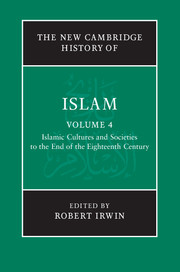Book contents
- Frontmatter
- Introduction
- PART I RELIGION AND LAW
- PART II SOCIETIES, POLITICS AND ECONOMICS
- PART III LITERATURE
- PART IV LEARNING, ARTS AND CULTURE
- 20 Education
- 21 Philosophy
- 22 The sciences in Islamic societies (750–1800)
- 23 Occult sciences and medicine
- 24 Literary and oral cultures
- 25 Islamic art and architecture
- 26 Music
- 27 Cookery
- Glossary
- Bibliography
- Index
- References
26 - Music
from PART IV - LEARNING, ARTS AND CULTURE
Published online by Cambridge University Press: 28 March 2011
- Frontmatter
- Introduction
- PART I RELIGION AND LAW
- PART II SOCIETIES, POLITICS AND ECONOMICS
- PART III LITERATURE
- PART IV LEARNING, ARTS AND CULTURE
- 20 Education
- 21 Philosophy
- 22 The sciences in Islamic societies (750–1800)
- 23 Occult sciences and medicine
- 24 Literary and oral cultures
- 25 Islamic art and architecture
- 26 Music
- 27 Cookery
- Glossary
- Bibliography
- Index
- References
Summary
From instinctive chanting to sophisticated singing
Reflecting on the question of the origin of music, al-Fārābῑ argues in his Kitāb al-msῑqῑ al-kabῑr (The great book of music) that, like other animals, man is instinctively motivated to express a range of emotions via sound. From this initial phase, through observation and experience, man attained a sophisticated vocal art. This discovery led to the gradual development of musical instruments with which he enhanced the art of singing. The musical theorist appears in the final stage of development, which coincides with the achievements in the realm of Islamic civilisation.
Four hundred years later Ibn Khaldūn (d. 808/1406), in his Muqaddima (Prolegomenon), describes another progressive development, from the primary, simple tunes of pre-Islamic society to the sophisticated forms of music created in the prosperous urban centres of Muslim society in its golden age. He also argues that unlike the forms of folk music and the cantillation of sacred texts, which are grasped by nature without instruction, professional musicians in urban centres base their art on codified norms.
The systematic crystallisation of such a newly sophisticated art after the advent of Islam may be described as the forging of a great musical tradition, which provided a vehicle and a standard for those who shared it to identify with others in a common civilisation. It refers to the skilful fusion of selected elements from the previous great traditions of conquered peoples with elements from the homogenous Arab ‘little tradition’.
- Type
- Chapter
- Information
- The New Cambridge History of Islam , pp. 743 - 750Publisher: Cambridge University PressPrint publication year: 2010



